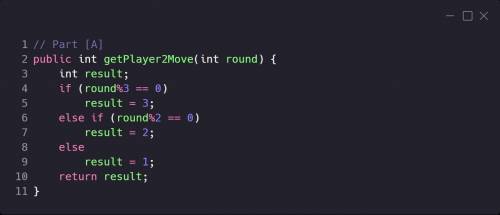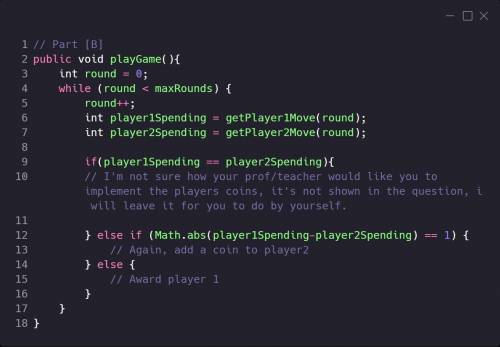
Computers and Technology, 24.12.2020 23:40 gstevens
This question involves a simulation of a two-player game. In the game, two simulated players each start out with an equal number of coins. In each round, each player chooses to spend either 1, 2, or 3 coins. Coins are then awarded to each player according to the following rules.
Same rule: If both players spend the same number of coins, player 2 gains 1 coin.
Off-by-one rule: If the players do not spend the same number of coins and the positive difference between the number of coins spent by the two players is 1, player 2 is awarded 1 coin.
Off-by-two rule: If the players do not spend the same number of coins and the positive difference between the number of coins spent by the two players is 2, player 1 is awarded 2 coins.
The game ends when the specified number of rounds have been played or when a player’s coin count is less than 3 at the end of a round.
The CoinGame class is shown below. You will write two methods in the CoinGame class.
public class CoinGame
{
private int startingCoins; // starting number of coins
private int maxRounds; // maximum number of rounds played
public CoinGame(int s, int r)
{
startingCoins = s;
maxRounds = r;
}
/** Returns the number of coins (1, 2, or 3) that player 1 will spend.
*/
public int getPlayer1Move()
{
/* implementation not shown. */
}
/** Returns the number of coins (1, 2, or 3) that player 2 will spend, as described in part (a).
*/
public int getPlayer2Move(int round)
{
/* to be implemented in part (a) */
}
/** Plays a simulated game between two players, as described in part (b).
*/
public void playGame()
{
/* to be implemented in part (b) */
}
}
In the simulation, player 2 will always play according to the same strategy. The number of coins player 2 spends is based on what round it is, as described below.
(a) You will write method getPlayer2Move, which returns the number of coins that player 2 will spend in a given round of the game. In the first round of the game, the parameter round has the value 1, in the second round of the game, it has the value 2, and so on. The method returns 1, 2, or 3 based on the following rules.
If round is divisible by 3, then return 3.
If round is not divisible by 3 but is divisible by 2, then return 2.
If round is not divisible by 3 and is not divisible by 2, then return 1.
Complete method getPlayer2Move below by assigning the correct value to result to be returned.
/** Returns the number of coins (1, 2, or 3) that player 2 will spend, as described in part (a).
*/
public int getPlayer2Move(int round)
{
int result;
return result;
}
Write the method playGame, which simulates a game between player 1 and player 2, based on the rules and example shown at the beginning of the question. Both player 1 and player 2 start the game with startingCoins coins. Computer player 1 spends 1, 2, or 3 coins based on the value returned by the method getPlayer1Move(). Computer player 2 spends 1, 2, or 3 coins based on the value returned by the method getPlayer2Move().
The game ends when maxRounds rounds have been played or when a player’s coin count is less than 3 at the end of a round.
At the end of the game, the winner is determined according to the following rules.
If both players have the same number of coins at the end of the game, the method prints "tie game".
If player 1 has more coins than player 2, the method prints "player 1 wins".
If player 2 has more coins than player 1, the method prints "player 2 wins".
(b) Assume that getPlayer2Move works as specified, regardless of what you wrote in part (a) . You must use getPlayer1Move and getPlayer2Move appropriately to receive full credit.
Complete method playGame below.
/** Plays a simulated game between two players, as described in part (b).
*/
public void playGame()

Answers: 1


Another question on Computers and Technology

Computers and Technology, 22.06.2019 23:00
Suppose s, t, and w are strings that have already been created inside main. write a statement or statements, to be added to main, that will determine if the lengths of the three strings are in order by length, smallest to largest. that is, your code should determine if s is strictly shorter than t, and if t is strictly shorter than w. if these conditions hold your code should print (the boolean value) true. if not, your code should print false. (strictly means: no ties) example: if s, t, and w are "cat", "hats", and "skies" your code should print true - their lengths are 3-4-5; but if s, t, and w are "cats" "shirt", and "trust", then print false - their lengths are 4-5-5 enter your code in the box below
Answers: 2

Computers and Technology, 23.06.2019 04:31
Q13 what function does a security certificate perform? a. creates user accounts b. scrambles data c. identifies users d. creates password policies e. provides file access
Answers: 1

Computers and Technology, 24.06.2019 07:40
What type of multimedia are live news feeds? live news feeds are examples of multimedia.
Answers: 2

Computers and Technology, 24.06.2019 09:30
Atype of researcher who uses computers to make sense of complex digital data
Answers: 1
You know the right answer?
This question involves a simulation of a two-player game. In the game, two simulated players each st...
Questions



Chemistry, 14.02.2020 22:02


Mathematics, 14.02.2020 22:02





Computers and Technology, 14.02.2020 22:02



English, 14.02.2020 22:03



Mathematics, 14.02.2020 22:04

Mathematics, 14.02.2020 22:04







